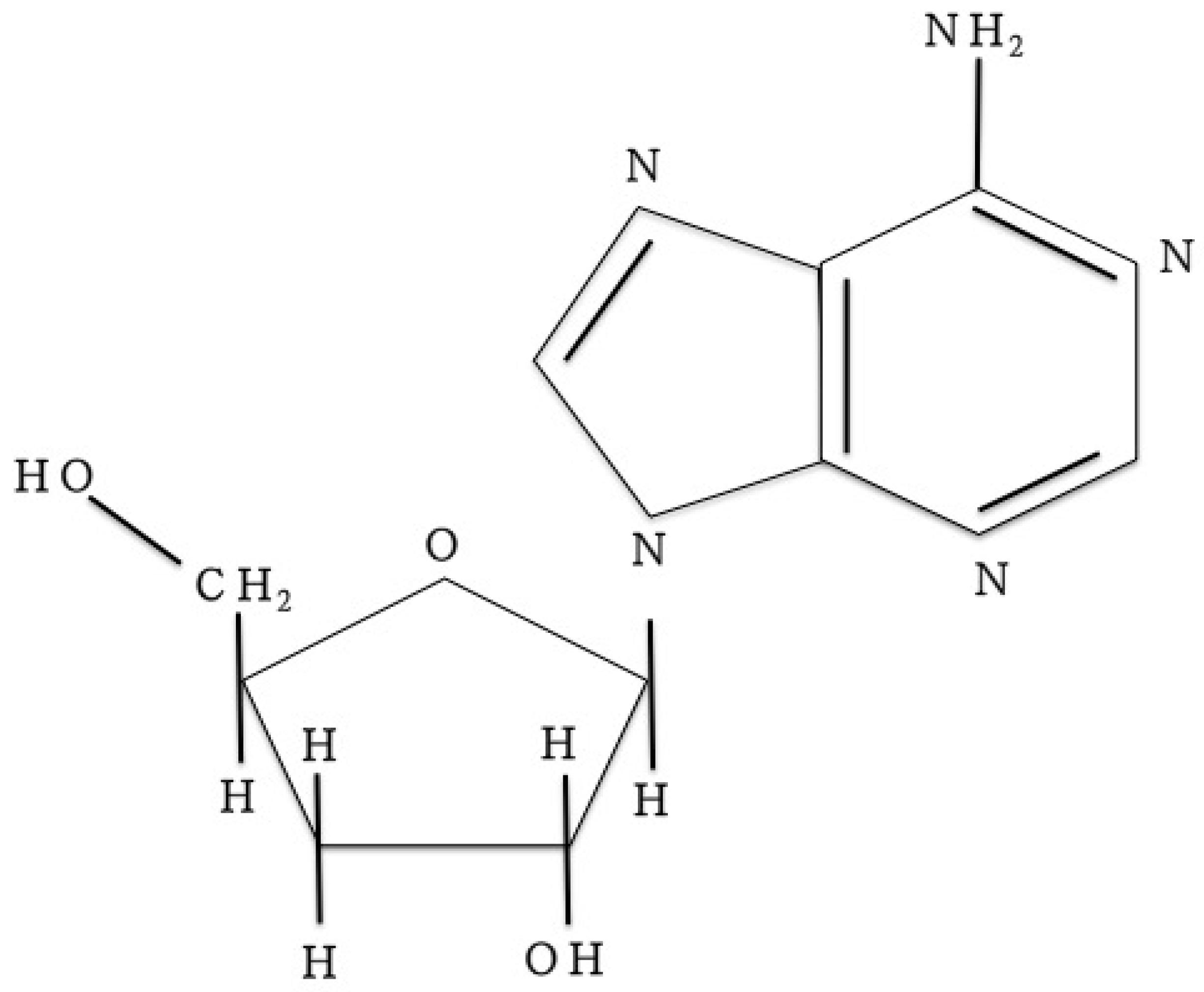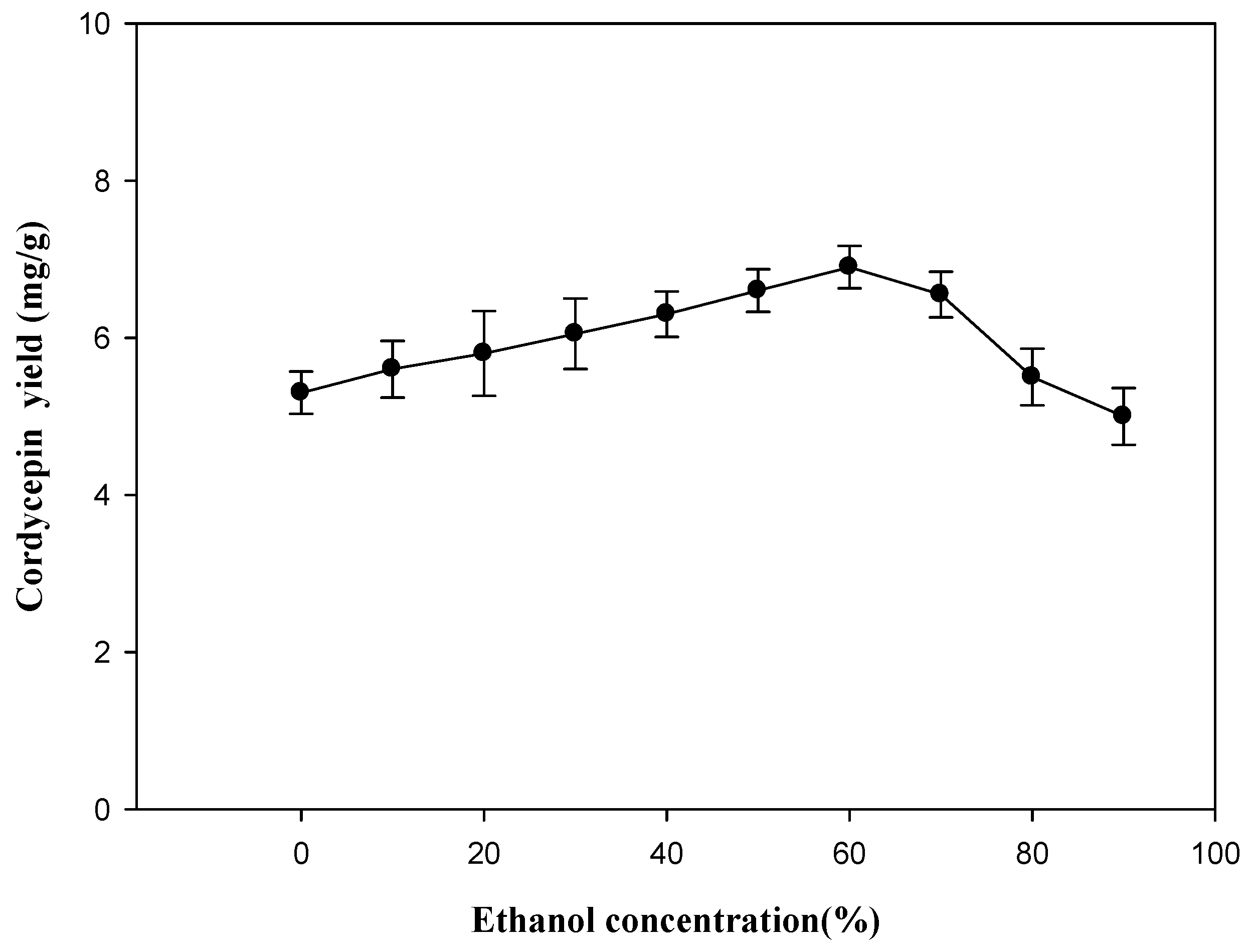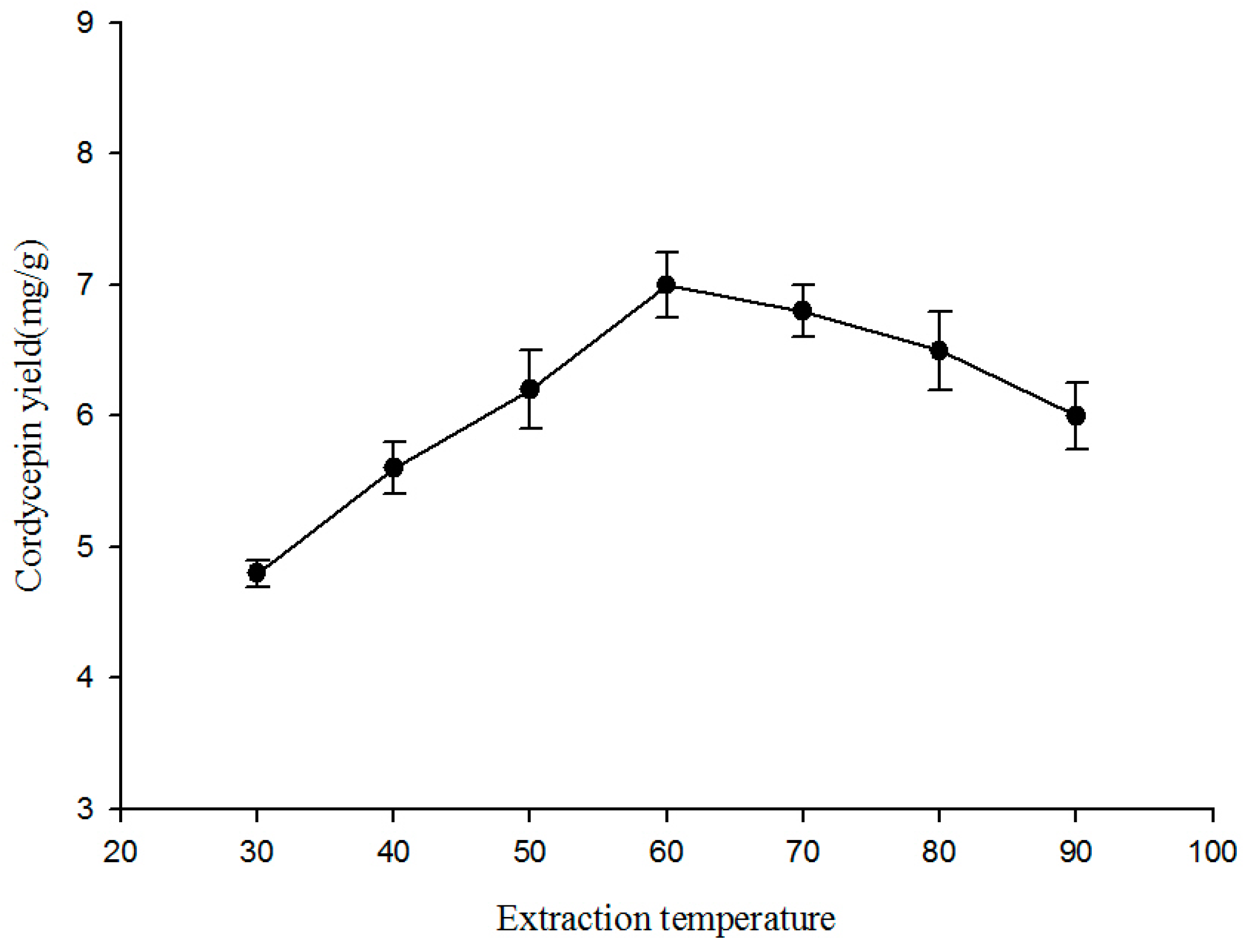Optimization of Ultrasonic-Assisted Extraction of Cordycepin from Cordyceps militaris Using Orthogonal Experimental Design
Abstract
:1. Introduction

2. Results and Discussion
2.1. Effects of Extraction Variables on Extraction Yield of Cordycepin
2.1.1. Extraction Time
2.1.2. Ethanol Concentration


2.1.3. Extraction Temperature

2.1.4. Ratio of Liquid to Solid

2.1.5. Extraction Frequency

2.2. Final Optimization by Orthogonal Experimental Design
| Levels | Factors | |||
|---|---|---|---|---|
| A | B | C | D | |
| Extraction Time (min) | Ethanol Concentration (%) | Extraction Temperature (°C) | Extraction Frequency (kHz) | |
| 1 | 40 | 30 | 55 | 28 |
| 2 | 50 | 40 | 60 | 40 |
| 3 | 60 | 50 | 65 | 56 |
| 4 | 70 | 60 | 70 | 80 |
| EXP | Factors | Extraction Yield (%) | |||
|---|---|---|---|---|---|
| A | B | C | D | ||
| 1 | 1 | 1 | 1 | 1 | 60.03 ± 0.62 |
| 2 | 1 | 2 | 2 | 2 | 70.84 ± 0.56 |
| 3 | 1 | 3 | 3 | 3 | 75.41 ± 0.63 |
| 4 | 1 | 4 | 4 | 4 | 74.53 ± 0.57 |
| 5 | 2 | 1 | 2 | 3 | 80.67 ± 0.47 |
| 6 | 2 | 2 | 1 | 4 | 77.93 ± 0.31 |
| 7 | 2 | 3 | 4 | 1 | 82.23 ± 0.24 |
| 8 | 2 | 4 | 3 | 2 | 81.43 ± 0.44 |
| 9 | 3 | 1 | 3 | 4 | 78.01 ± 0.63 |
| 10 | 3 | 2 | 4 | 3 | 77.84 ± 0.52 |
| 11 | 3 | 3 | 1 | 2 | 83.16 ± 0.54 |
| 12 | 3 | 4 | 2 | 1 | 84.02 ± 0.33 |
| 13 | 4 | 1 | 4 | 2 | 71.68 ± 0.65 |
| 14 | 4 | 2 | 3 | 1 | 76.24 ± 0.23 |
| 15 | 4 | 3 | 2 | 4 | 80.08 ± 0.34 |
| 16 | 4 | 4 | 1 | 3 | 80.23 ± 0.44 |
| K1 | 280.81 | 290.39 | 290.39 | 302.52 | - |
| K2 | 322.26 | 302.85 | 302.85 | 307.11 | - |
| K3 | 323.03 | 320.88 | 311.09 | 314.15 | - |
| K4 | 308.23 | 320.21 | 306.28 | 310.55 | - |
| k1 | 70.20 | 72.60 | 72.60 | 75.63 | - |
| k2 | 80.57 | 75.71 | 75.71 | 76.78 | - |
| k3 | 80.76 | 80.22 | 77.77 | 78.54 | - |
| k4 | 77.06 | 80.05 | 76.57 | 77.64 | - |
| R | 10.56 | 7.62 | 5.18 | 2.91 | - |
| Factors | SS | df | MS | F | P | Significant |
|---|---|---|---|---|---|---|
| A | 292 | 3 | 97.270020 | 9.080411 | 0.051436 | ** |
| B | 163 | 3 | 54.187990 | 5.058590 | 0.108024 | * |
| C | 28 | 3 | 9.440320 | 0.881279 | 0.540148 | - |
| D | 18 | 3 | 6.149190 | 0.574043 | 0.670151 | - |
| Error | 32.1362 | 51 | 10.71207 | - | - | - |
| Total | 9.31 | 26 | - | - | - | - |
2.3. Comparison between UAE and Conventional Immersion Extraction
| Extraction Method | Ultrasonic-Assisted Extraction | Immersion Extraction | |
|---|---|---|---|
| Extraction time (h) | 1 | 1 | 24 |
| Extraction temperature (°C) | 65 | 65 | 65 |
| Ratio of liquid to solid (mL/g) | 1:20 | 1:250 | 1:250 |
| Recovery (%) | 86.98% ± 0.23% b | 21.43% ± 1.13% c | 95.23% ± 3.11% a |
3. Experimental Section
3.1. Materials
3.2. Conventional Immersion Extraction
3.3. Ultrasonic-Assisted Extraction
3.4. Optimization of Ultrasonic-Assisted Extraction Condition
3.5. Analysis of Cordycepin in the Extracts
4. Conclusions
Acknowledgments
Author Contributions
Conflicts of Interest
References
- Joung, H.J.; Kim, Y.S.; Hwang, J.W.; Han, Y.K.; Jeong, J.H.; Lee, J.S.; Moon, S.H.; Jeon, B.T.; Park, P.J. Anti-inflammatory effects of extract from Haliotis discus hannai fermented with Cordyceps militaris mycelia in RAW264.7 macrophages through TRIF-dependent signaling pathway. Fish Shellfish Immunol. 2014, 38, 184–189. [Google Scholar] [CrossRef] [PubMed]
- Yu, R.; Yang, W.; Song, L.; Yan, C.; Zhang, Z.; Zhao, Y. Structural characterization and antioxidant activity of a polysaccharide from the fruiting bodies of cultured Cordyceps militaris. Carbohydr. Polym. 2007, 70, 430–436. [Google Scholar] [CrossRef]
- Mao, X.B.; Eksriwong, T.; Chauvatcharin, S.; Zhong, J.J. Optimization of carbon source and carbon/nitrogen ratio for cordycepin production by submerged cultivation of medicinal mushroom Cordyceps militaris. Process Biochem. 2005, 40, 1667–1672. [Google Scholar] [CrossRef]
- Wu, Z.L.; Wang, X.X.; Chen, W.Y. Inhibitory effect of Cordyceps sinensis and Cordyceps militaris on human glomerular mesangial cell proliferation induced by native LDL. Cell Biochem. Funct. 2000, 18, 93–97. [Google Scholar] [CrossRef] [PubMed]
- Ahn, Y.J.; Park, S.J.; Lee, S.G.; Shin, S.C.; Choi, D.H. Cordycepin: Selective growth inhibitor derived from liquid culture of Cordyceps militaris against Clostridium spp. J. Agric. Food Chem. 2000, 48, 2744–2748. [Google Scholar] [CrossRef] [PubMed]
- Cunningham, K.G.; Manson, W.; Spring, F.S.; Hutchinson, S.A. Cordycepin, a metabolic product isolated from cultures of Cordyceps militaris (Linn.) Link. Nature 1950, 166, 2299–2300. [Google Scholar] [CrossRef]
- Zhou, X.X.; Meyer, C.U.; Schmidtke, P.; Zepp, F. Effect of cordycepin on interleukin-10 production of human peripheral blood mononuclear cells. Eur. J. Pharmacol. 2002, 453, 309–317. [Google Scholar] [CrossRef] [PubMed]
- De Julian-Ortiz, J.V.; Galvez, J.; Munoz-Collado, C.; Garcia-Domenech, R.; Gimeno-Cardona, C. Virtual combinatorial syntheses and computational screening of new potential anti-herpes compounds. J. Med. Chem. 1999, 17, 3308–3314. [Google Scholar] [CrossRef]
- Sugar, A.M.; Mccaffrey, R.P. Antifungal activity of 30-deoxyadenosine (cordycepin). Antimicrob. Agents Chemother. 1988, 42, 1424–1427. [Google Scholar]
- Shin, S.; Lee, S.; Kwon, J.; Moon, S.; Lee, S.; Lee, C.K.; Cho, K.; Ha, N.J.; Kim, K. Cordycepin suppresses expression of diabetes regulating genes by inhibition of lipopolysaccharide-induced inflammation in macrophages. Immune Netw. 2009, 9, 98–105. [Google Scholar] [CrossRef] [PubMed]
- Kim, H.; Shrestha, B.; Lim, S.; Yoon, D.; Chang, W.; Shin, D.; Han, S.; Park, S.; Park, J.; Park, H. Cordycepin inhibits lipopolysaccharide-induced inflammation by the suppression of NF-κB through Akt and p38 inhibition in RAW 264.7 macrophage cells. Eur. J. Pharmacol. 2006, 545, 192–199. [Google Scholar] [CrossRef] [PubMed]
- Yun, Y.; Han, S.; Lee, S.; Ko, S.; Lee, C.; Ha, N.; Kim, K. Anti-diabetic effects of CCCA, CMESS, and cordycepin from Cordyceps militaris and the immune responses in streptozotocin-induced diabetic mice. Nat. Prod. Sci. 2003, 9, 291–298. [Google Scholar]
- Cho, M.; Lee, D.; Kim, M.; Sung, J.; Ham, S. Antimutagenicity and cytotoxicity of cordycepin isolated from Cordyceps militaris. Food Sci. Biotechnol. 2003, 12, 472–475. [Google Scholar]
- Masudaa, M.; Dasa, S.K.; Hatashitab, M.; Fujiharaa, S.; Sakurai, A. Efficient production of cordycepin by the Cordyceps militaris mutant G81–3 for practical use. Process Biochem. 2014, 49, 181–187. [Google Scholar] [CrossRef]
- Kim, S.B.; Ahn, B.; Kim, M.; Ji, H.J.; Shin, S.K.; Hong, I.P.; Kim, C.Y.; Hwang, B.Y.; Lee, M.K. Effect of Cordyceps militaris extract and active constituents on metabolic parameters of obesity induced by high-fat diet in C58BL/6J mice. J. Ethnopharmacol. 2014, 151, 478–484. [Google Scholar] [CrossRef] [PubMed]
- Wu, F.C.; Chen, Y.L.; Chang, S.M.; Shih, I.L. Cultivation of medicinal Caterpillar fungus, Cordyceps militaris (Ascomycetes), and production of cordycepin using the spent medium from levan fermentation. Int. J. Med. Mushrooms 2013, 15, 393–405. [Google Scholar] [CrossRef] [PubMed]
- McDonald, F.E.; Gleason, M.M. Asymmetric synthesis of nucleosides via molybdenum-catalyzed alkynol cycloisomerization coupled with stereoselective glycosylations of deoxyfuranose glycals and 3-amidofuranose glycals. J. Am. Chem. Soc. 1996, 118, 6648–6659. [Google Scholar] [CrossRef]
- Ni, H.; Zhou, X.H.; Li, H.H.; Huang, W.F. Column chromatographic extraction and preparation of cordycepin from Cordyceps militaris waster medium. J. Chromatogr. B 2009, 877, 2135–2141. [Google Scholar] [CrossRef]
- Li, X.; Wang, Z.; Wang, L.; Walid, E.; Zhang, H. Ultrasonic-assisted extraction of polysaccharides from Hohenbuehelia serotina by response surface methodology. Int. J. Biol. Macromol. 2012, 51, 523–530. [Google Scholar] [CrossRef] [PubMed]
- Paniwnyk, L.; Cai, H.; Albu, S.; Mason, T.J.; Cole, R. The enhancement and scale up of the extraction of anti-oxidants from Rosmarinus officinalis using ultrasound. Ultrason. Sonochem. 2009, 16, 287–292. [Google Scholar] [CrossRef] [PubMed]
- Hsieh, C.W.; Cheng, J.Y.; Wang, T.H.; Wang, H.J.; Ho, W.J. Hypoglycaemic effects of Ajuga extract in vitro and in vivo. J. Funct. Food 2014, 6, 224–230. [Google Scholar] [CrossRef]
- Esclapez, M.D.; Garcia-Perez, J.V.; Mulet, A.; Carcel, J.A. Ultrasound-assisted extraction of natural products. Food Eng. Rev. 2011, 3, 108–120. [Google Scholar] [CrossRef]
- Tetik, N.; Yuksel, E. Ultrasound-assisted extraction of d-pinitol from carob pods using response surface methodology. Ultrason. Sonochem. 2014, 21, 860–865. [Google Scholar] [CrossRef] [PubMed]
- Tao, Y.; Wu, D.; Zhang, Q.A.; Sun, D.W. Ultrasound-assisted extraction of phenolics from wine lees: Modeling, optimization and stability of extracts during storage. Ultrason. Sonochem. 2014, 21, 706–715. [Google Scholar] [CrossRef] [PubMed]
- Ji, L.; Si, Y.; Liu, H.; Song, X.; Zhu, W.; Zhu, A. Application of orthogonal experimental design in synthesis of mesoporous bioactive glass. Microporous Mesoporous Mater. 2014, 184, 122–126. [Google Scholar] [CrossRef]
- Cui, W.; Li, X.; Zhou, S.; Weng, J. Investigation on process parameters of electrospinning system through orthogonal experimental design. J. Appl. Polym. Sci. 2007, 103, 3105–3112. [Google Scholar] [CrossRef]
- Vinatoru, M. An overview of the ultrasonically assisted extraction of bioactive principles from herbs. Ultrason. Sonochem. 2001, 8, 303–313. [Google Scholar] [CrossRef] [PubMed]
- Song, J.F.; Liu, C.Q.; Li, D.J.; Jin, B.Q. Optimization of cordycepin extraction from cultured Cordyceps militaris by HPLC-DAD coupled with uniform design. J. Chem. Technol. Biotechnol. 2007, 82, 1122–1126. [Google Scholar] [CrossRef]
- Wang, L.; Weller, C.L. Recent advances in extraction of nutraceuticals from plants. Trends Food Sci. Technol. 2006, 17, 300–312. [Google Scholar] [CrossRef]
- Dong, J.; Liu, Y.; Liang, Z.; Wang, W. Investigation on ultrasound-assisted extraction of salvianolic acid B from Salvia miltiorrhiza root. Ultrason. Sonochem. 2010, 17, 61–65. [Google Scholar] [CrossRef] [PubMed]
- Xia, E.Q.; Yu, Y.Y.; Xu, X.R.; Deng, G.F.; Guo, Y.J.; Li, H.B. Ultrasound-assisted extraction of oleanolic acid and ursolic acid from Ligustrum lucidum Ait. Ultrason. Sonochem. 2012, 19, 772–776. [Google Scholar] [CrossRef] [PubMed]
- Zhang, H.F.; Yang, X.H.; Zhao, L.D.; Wang, Y. Ultrasonic-assisted extraction of epimedin C from fresh leaves of Epimedium and extraction mechanism. IFSET 2009, 10, 54–60. [Google Scholar]
- Valachovic, P.; Pechova, A.; Mason, T.J. Towards the industrial production of medicinal tincture by ultrasound-assisted extraction. Ultrason. Sonochem. 2001, 8, 111–117. [Google Scholar] [CrossRef] [PubMed]
- Li, H.; Chen, B.; Yao, S. Application of ultrasonic technique for extracting chlorogenic acid from Eucommia ulmodies Oliv. (E. ulmodies). Ultrason. Sonochem. 2005, 12, 295–300. [Google Scholar] [CrossRef] [PubMed]
- Sample Availability: Samples of the compounds are available from the authors.
© 2014 by the authors. Licensee MDPI, Basel, Switzerland. This article is an open access article distributed under the terms and conditions of the Creative Commons Attribution license ( http://creativecommons.org/licenses/by/4.0/).
Share and Cite
Wang, H.-J.; Pan, M.-C.; Chang, C.-K.; Chang, S.-W.; Hsieh, C.-W. Optimization of Ultrasonic-Assisted Extraction of Cordycepin from Cordyceps militaris Using Orthogonal Experimental Design. Molecules 2014, 19, 20808-20820. https://doi.org/10.3390/molecules191220808
Wang H-J, Pan M-C, Chang C-K, Chang S-W, Hsieh C-W. Optimization of Ultrasonic-Assisted Extraction of Cordycepin from Cordyceps militaris Using Orthogonal Experimental Design. Molecules. 2014; 19(12):20808-20820. https://doi.org/10.3390/molecules191220808
Chicago/Turabian StyleWang, Hsiu-Ju, Meng-Chun Pan, Chao-Kai Chang, Shu-Wei Chang, and Chang-Wei Hsieh. 2014. "Optimization of Ultrasonic-Assisted Extraction of Cordycepin from Cordyceps militaris Using Orthogonal Experimental Design" Molecules 19, no. 12: 20808-20820. https://doi.org/10.3390/molecules191220808





